Shrimps eat almost everything in their habitat. If you ask, “What do shrimp eat the most?” Plankton, algae, and other tiny organisms will be at the top of this list.
However, you may notice slight differences in the food habit between the saltwater (oceanic) shrimps and the freshwater shrimps. Even when they are in aquariums, their diets may vary.
What Do Shrimps Eat? (In Ocean, Freshwater and Aquarium)
Here is a detailed discussion of shrimps’ food habits regarding their habitat (Ocean, Freshwater, Aquarium).
What do oceanic (saltwater) shrimps eat?
Oceanic shrimps are omnivorous and eat both plants and animals. They have a diverse diet that includes algae, seagrass, dead skin of other organisms, small fish, and other food items. Shrimps may also eat plankton and tiny invertebrates, such as copepods and amphipods if they are present in the water.
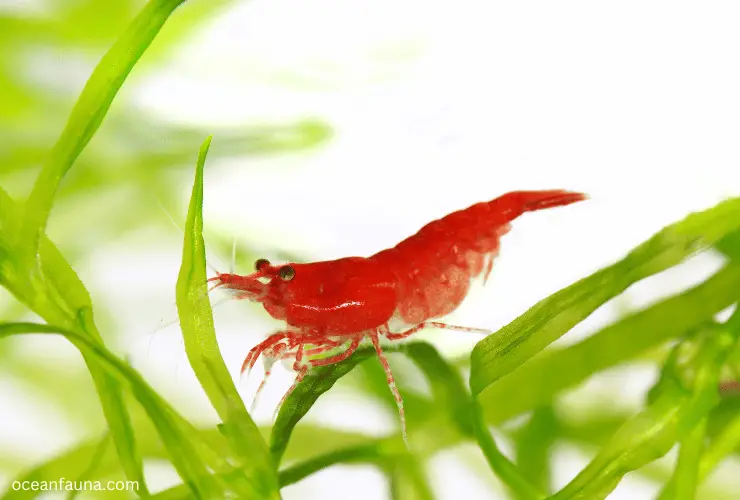
Also, they feed on small crustaceans, mollusks, finfish, ophiuroids, polychaetes, and other slow-moving benthic organisms.
Algae is a major food source for these shrimps; they consume it in both live and dead forms. They also feed on seagrass, providing essential nutrients and minerals for their growth and development.
Additionally, they consume other small aquatic animals, such as small fish and crustaceans. These shrimps have a powerful set of mandibles that can crush and tear apart the exoskeletons of these prey items.
Moreover, these shrimps are known to feed on detritus, which consists of dead organic matter, such as decaying plants and animals. By consuming the dead skin of other organisms, they help maintain the balance of ecosystems in their habitat.
Shrimps also eat plankton, including both phytoplankton and zooplankton. Phytoplankton is a type of microscopic algae that forms the base of the marine food chain. It is an important source of food for many small marine animals, including shrimps.
Conversely, zooplankton consists of small invertebrates such as copepods, krill, and small crustaceans. It is also an important food source for shrimps.
What do freshwater shrimps eat?
Freshwater shrimps can be found in creeks and streams, where they also feed on various food sources. They are opportunistic eaters, and their diet mainly consists of algae, bacteria, and other microorganisms. They use their small pincers to search for these food sources on rocks, gravel, and other surfaces.
In addition to these microorganisms, freshwater shrimps will also consume decaying plant matter, such as leaves and branches that have fallen into their waterways. This dead plant material provides a source of nutrients that can sustain them when other food sources are scarce.
Interestingly, like saltwater shrimps, they are also known to scavenge dead fish and even dead shrimp that they come across in their environment. While this may seem cannibalistic, it is simply a matter of survival – they do not actively hunt or kill other shrimp or fish but will consume them if they are already dead.
What do aquarium shrimps eat?
Aquarium shrimps also eat almost everything. They will often feed on algae and bacteria growing on rocks, plants, or tank walls, and this is the primary source of nutrients for them in most aquariums.
Furthermore, just like freshwater and saltwater shrimps, they can consume dead and decomposing plant matter or other organic waste that accumulates in the tank. This decomposition process plays a crucial role in maintaining an aquarium’s stable and flourishing ecosystem.
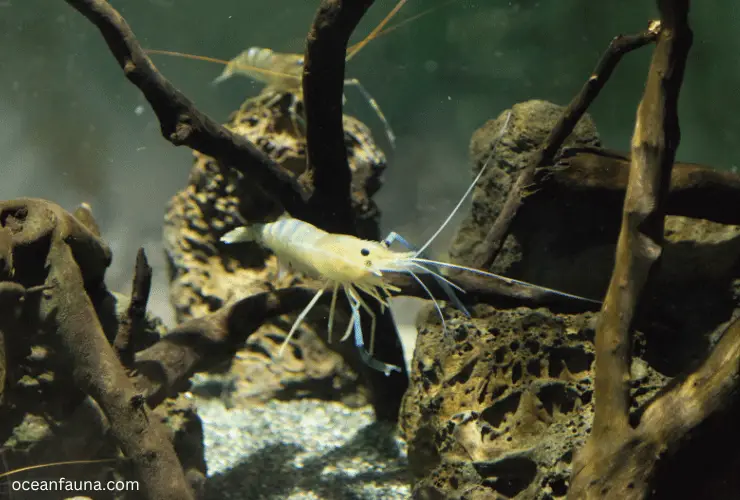
In terms of prepared foods, aquarium shrimps can eat a variety of options, including pellets, flakes, and even frozen or live foods. Many species of shrimp, including cherry shrimp, Amano shrimp, and ghost shrimp, will happily consume small bits of fish food that remain uneaten by other aquarium inhabitants.
Shrimp enjoy eating green foods, including spinach and nettles, as well as vegetables like kuri squash and zucchini. In addition to these plant-based foods, shrimp require some protein to prevent them from attacking younger or weaker shrimp.
Live and frozen foods such as brine shrimp, bloodworms, or daphnia are also popular options for feeding aquarium shrimps, especially when they are growing and need a lot of protein to support their rapid development.
Remember, overfeeding aquarium shrimps can be as problematic as underfeeding them; excess food can cause pollution in the tank, leading to poor water quality and unhealthy tank conditions. Therefore, monitor the amount of food an aquarium shrimp consumes and adjust the feeding schedule as needed.
Are Shrimps Omnivores?
Yes, most shrimps are indeed considered omnivores, meaning they have a diet consisting of both plant and animal matter. However, some species of shrimps have evolved to become specialized feeders to better survive in their particular environments.
For example, some shrimps are filter feeders, which means that they use their bristly legs to sift through water and collect small particles of food, such as plankton.
Other shrimp species are adapted to the rocky shorelines, where they scrape algae and other microscopic organisms from rocks. Still, the majority of shrimp are considered generalist omnivores that will eat a variety of food sources that are available to them.
Keep in mind that shrimp play an important role in the food chain, acting as prey for a variety of larger animals such as fish, sea turtles, and birds. As omnivores, they help to recycle nutrients and keep ecosystems balanced.
While some species of shrimp may have specialized diets, most are considered omnivores that play an important role in marine ecosystems.
Do Shrimp Eat Fish Poop?
No, in their natural habitat, shrimp do not eat fish poop. Even though it might resemble food, shrimp should not consume poop as it can lead to unnecessary health risks as well as contamination of the tank.
However, aquarium shrimps are known for their habit of cleaning up the tank by eating leftovers from the bottom of the tank or dead plants and fish. But they will not eat poop; if they do, they will immediately spit it out once they realize it is not food.
Also, eating fish poop could potentially harm shrimp’s health as it may contain harmful bacteria and toxins that could affect their digestive system.
Additionally, ingesting too much poop could increase ammonia and nitrate levels in the tank, which could be detrimental to the overall health of the aquatic ecosystem.
Therefore, maintain the aquarium’s cleanliness by regularly cleaning it and performing water changes to ensure a healthy environment for all the aquatic inhabitants.
Do Shrimp Eat Their Own Species?
Yes, shrimp do eat their own species under certain circumstances. Research has shown that certain types of shrimp, particularly those in the Gammarus duebeni species, have been observed cannibalizing their own kind. However, this behavior is uncommon and typically only occurs in specific situations.
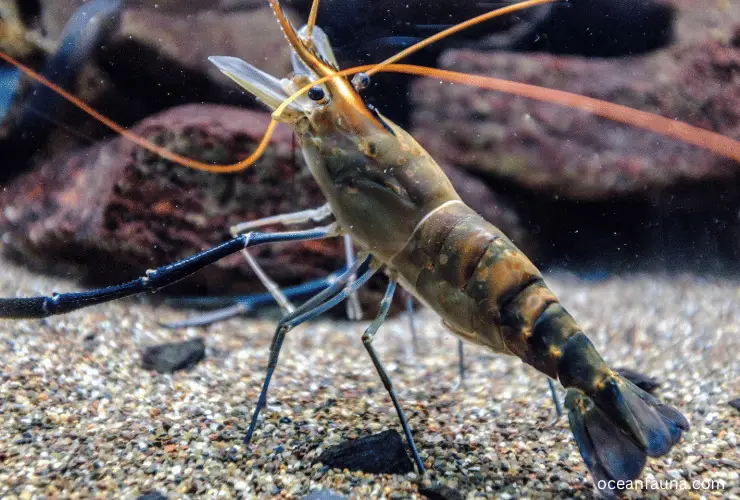
One of the main factors that can lead shrimp to eat each other is the presence of parasites. Infected shrimp are more likely to display aggressive behavior towards uninfected and infected counterparts.
They also tend to be more voracious in their feeding habits, making them more likely to cannibalize other species. This behavior is thought to be related to the transmission of parasites, as infected shrimp may be more likely to spread the parasites to others through physical contact or consumption.
Additionally, cannibalizing other shrimp may provide infected individuals with a source of nourishment that can help them resist the effects of the parasites.
While cannibalism among shrimp is not a common occurrence, it is a reminder of the complex and often surprising behaviors that can be observed in animal populations. Further research may help shed light on the precise mechanisms behind shrimp cannibalism and how it might impact population dynamics.
How Do Shrimps Catch Food?
Shrimps use their pereiopods to catch their food, which are located near their mouth. These specialized appendages are adapted for grasping, holding, and manipulating food. When a shrimp comes across a potential meal, it extends its pereiopods toward the prey and captures it swiftly.
Once the shrimp has caught the food, it brings it to its buccal cavity, chewed and broken down into smaller pieces.
Shrimps are mainly omnivorous and will eat various foods, including algae, aquatic plants, small fish, and invertebrates such as plankton and small snails. However, if food is scarce or of poor quality, shrimps may resort to cannibalism and eat their own species.
The way shrimps hunt for their food is similar to that of other crustaceans, such as crabs and lobsters. They use their pereiopods and other specialized structures to catch and manipulate their prey.
Since shrimps are relatively small animals, they must quickly and efficiently capture their food. They use their speed and agility to catch their prey before it has a chance to escape.
The Digestive System of Shrimps: How Do Shrimps Digest?
The digestive system of shrimps is a complex network of organs and processes that enable them to efficiently break down and absorb their food. Shrimp have a unique digestive system that relies heavily on the movement of their bowel muscle to transport food through their intestine.
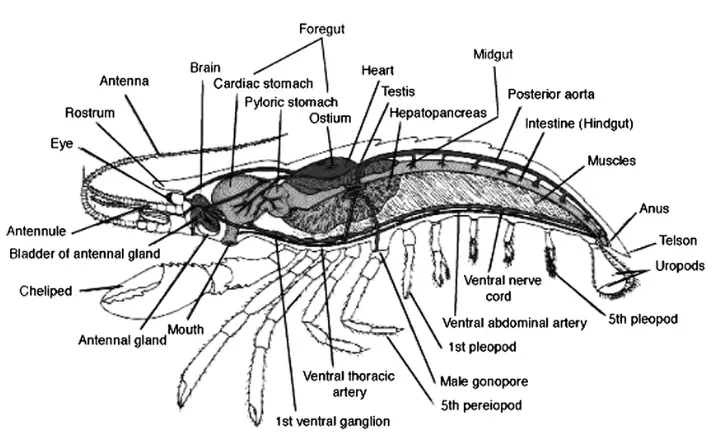
Shrimps are not able to store large amounts of food in their cardiac and pyloric stomachs, making it important for them to keep eating almost constantly. This is because the food is quickly moved through their system, so they constantly need a new source of nutrition.
The process of digestion in shrimps begins in the mouth, where they use their small and sharp mandibles to break down their food into smaller particles. These particles then pass into the stomach, where enzymes and hydrochloric acid further break them down.
From here, the food is transported through the intestine by wavelike movements of the bowel muscle and continues to be broken down and absorbed by the body.
Interestingly, shrimps have a special organ near their stomach called the hepatopancreas, which is responsible for the secretion of digestive enzymes. This organ plays a key role in the breakdown of nutrients, such as proteins, carbohydrates, and fats.
Once digestion is complete, the waste products are excreted through the anus, and the process starts all over again. It is important to note that shrimps are very efficient at digesting their food, and the absorption of nutrients is very high, allowing them to get the most out of their food.
How Much Do Shrimps Eat in A Day?
Shrimps are voracious eaters, consuming a significant portion of their body weight in food each day. In fact, some species of shrimp can consume up to 51.0% of their food weight per day!
To put this into perspective, imagine a 1-pound shrimp consuming roughly half a pound of food in just 24 hours. That’s an impressive feat for these tiny creatures with their relatively small mouths.
But why do shrimps eat so much? Well, it’s simple – they need to consume a lot of food to provide their bodies with the energy and nutrients required for survival and growth. Shrimp are especially fast-growing creatures, so they need to eat a lot to keep up with their body’s demands.
Of course, the total amount of food a shrimp will eat each day will depend on various factors, including the species of shrimp, the environmental conditions they’re living in, and their overall health. But one thing is for sure – these little creatures have some serious appetites!
How Often Do You Feed Shrimp in An Aquarium?
Feeding frequency for shrimp in an aquarium varies based on a few factors, such as the tank’s age and the setup’s overall conditions.
Typically, most shrimp keepers opt to feed their colonies every day or every two to three days. However, this can change depending on the state of the tank’s biofilm and algae growth, as these natural food sources can provide sustenance throughout the day.
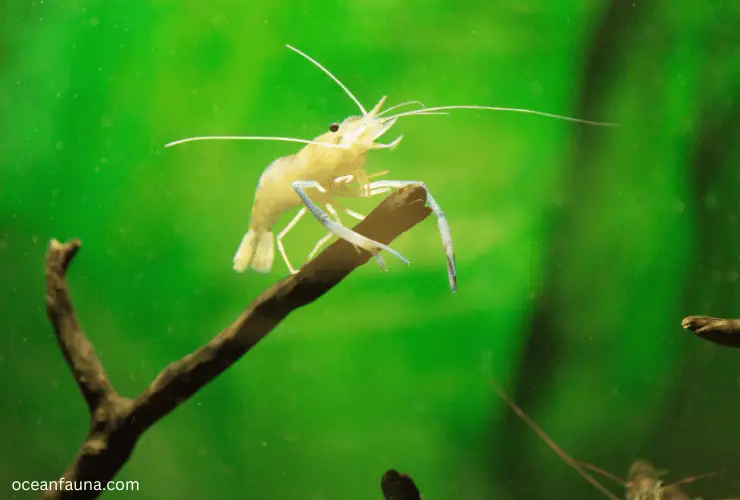
In tanks that have been up and running for months, there is likely to be a decent amount of biofilm and algae present, making it possible for the shrimp to graze and feed themselves without needing additional input from their keepers.
In these situations, less frequent feeding is appropriate as the shrimp can get the nourishment they need from the available food sources in their environment.
On the other hand, newly established tanks or those lacking sufficient biofilm or algae may require daily feeding from their keepers. This helps to ensure that the shrimp get enough food to fuel their growth and development since they don’t have enough food in their surroundings.
How Long Do Shrimps Survive Without Food?
Can shrimp survive without being fed? Shrimps can survive for a maximum of two weeks without food in captivity or aquaculture settings. This is because water quality and food are carefully controlled in such settings, and shrimps are often fed with nutrient-rich pellets that provide them with all the necessary nutrients for survival.
However, shrimps can survive for a few days without food in natural habitats like rivers, oceans, and other water bodies. This is because they have to search for their food, and their access to food is often unpredictable.
Another factor that determines how long shrimps can go without food is their species. While some species may survive for a few days without food, others may require a regular food supply to survive.
For instance, freshwater shrimps like the cherry shrimp can survive for up to a week without food, while marine shrimps like the ghost shrimp can survive for about three days.
While shrimps can survive without food for some time, their lack of food can severely affect their health and growth. Shrimps that are starved for an extended period may become weak, malnourished, and more susceptible to diseases.
Also, the prolonged absence of food can trigger a natural response called autophagy, where cells start to break down proteins to provide the energy required for survival.
Predators of Shrimps
Shrimps are among the most hunted creatures in the ocean and are a primary food source for many carnivorous and omnivorous animals. Several marine animals, including crabs, sea urchins, starfish, seabirds, whales, sharks, seahorses, and dolphins, are known to prey on shrimps.
Crabs are considered one of the major predators of shrimps, as they are opportunistic feeders and can swiftly capture shrimps.
On the other hand, sea urchins use their spines to grab shrimps and break them apart. Starfish also feed on shrimps, and their feeding strategy involves prying open the shells of shrimps to gain access to the underlying flesh.
Seabirds such as gulls are also a threat to shrimps. These birds have a keen sense of sight and can detect shrimps swimming near the water’s surface. They then swoop down and grab the shrimp with their beaks.
Whales, especially baleen whales, feed on shrimps that form part of the zooplankton population in the ocean.
Sharks, seahorses, and dolphins are some of the other predators of shrimps. Sharks can detect the scent of shrimps from a great distance and can swim quickly to catch them.
Seahorses, which are known for their small size, feed on small shrimps and other crustaceans. Dolphins, on the other hand, are opportunistic predators and consume a range of marine animals, including shrimps.
In addition to these natural predators, humans also hunt and consume shrimps. It is estimated that approximately 4.2 million tons of shrimp are consumed by humans each year, making shrimp one of the most commercially important seafood products in the world.
As a result, the demand for shrimps has increased, and aquaculture practices have been developed to meet the demand for this popular food item.
Conclusion
Now you have a compact knowledge of what and how shrimps eat regarding their habitat. Plankton, algae, and plant detritus are the primary food sources for shrimps. They even consume their own species for food.
Let me know if you want to know more about their food habits. I will answer them as soon as possible.


5 thoughts on “What Do Shrimps Eat? [Complete Food List]”